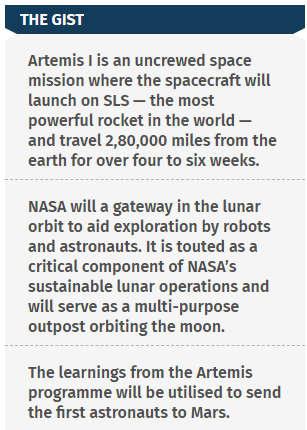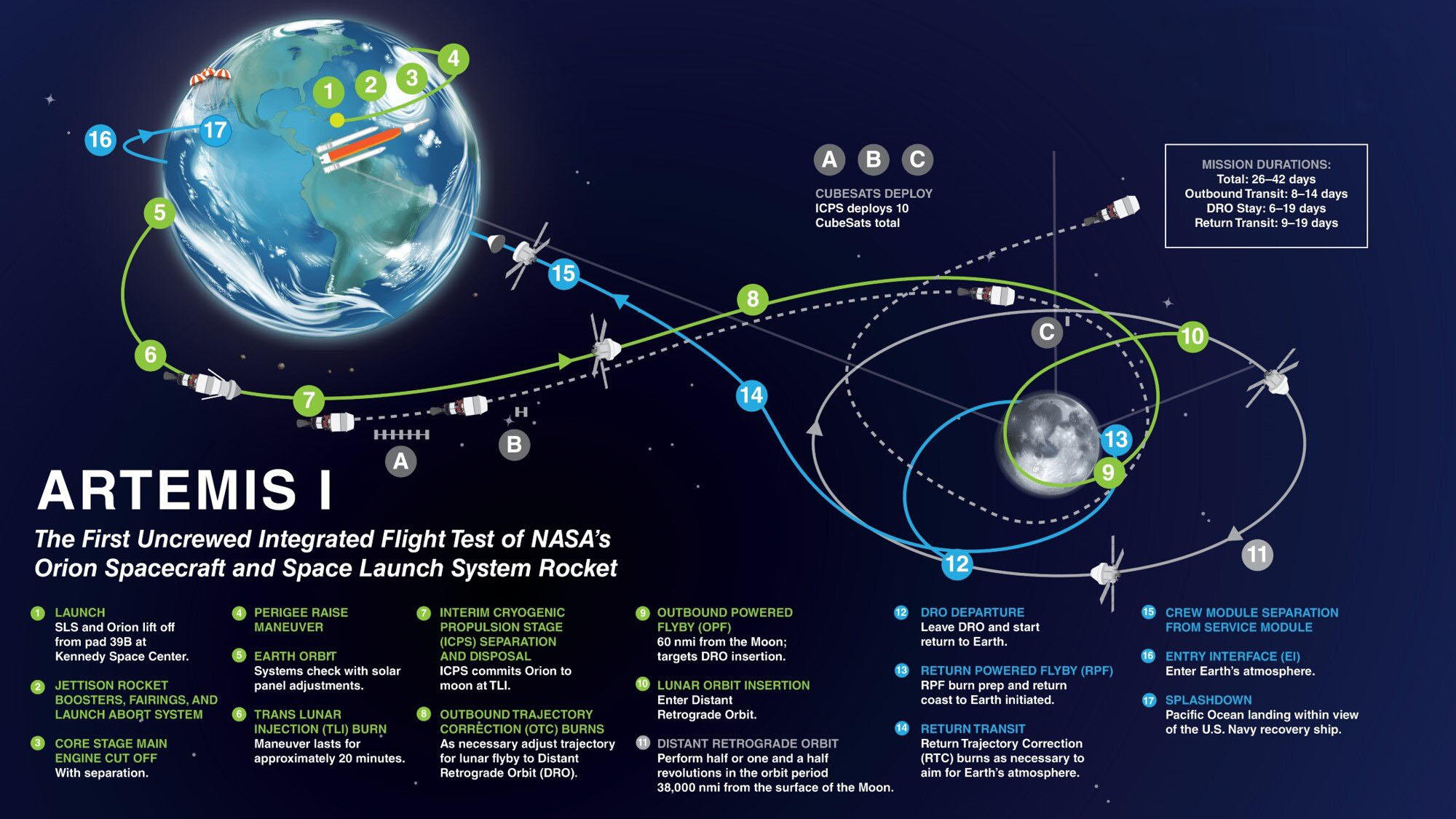Science & Technology
NASA’s Artemis Program
- 24 Mar 2022
- 9 min read
For Prelims: National Aeronautics and Space Administration (NASA), Artemis I, moon mission, Chandrayaan project, History of Moon Exploration
For Mains: Space Exploration, Moon mission, Sending Human on Moon and Mars
Why in News?
Recently, the National Aeronautics and Space Administration (NASA) rolled out its Artemis I moon mission to the launchpad for testing at the Kennedy Space Centre in Florida, United States.
What is Artemis Mission?
- NASA’s Artemis mission is touted as the next generation of lunar exploration, and is named after the twin sister of Apollo from Greek mythology.
- Artemis is also the goddess of the moon.
- It is the first in a series of increasingly complex missions that will enable human exploration to the Moon and Mars.
- With the Artemis programme, NASA aims to land humans on the moon by 2024, and it also plans to land the first woman and first person of colour on the moon.
- NASA will establish an Artemis Base Camp on the surface and a gateway (the lunar outpost around the Moon) in lunar orbit to aid exploration by robots and astronauts.
- The gateway is a critical component of NASA’s sustainable lunar operations and will serve as a multi-purpose outpost orbiting the moon.
- Other space agencies are also involved in the Artemis programme.
- Canadian Space Agency has committed to providing advanced robotics for the gateway,
- The European Space Agency will provide the International Habitat and the ESPRIT module, which will deliver additional communications capabilities among other things.
- The Japan Aerospace Exploration Agency plans to contribute habitation components and logistics resupply.
What are Key Points of Artemis I Mission?
- Artemis I, formerly Exploration Mission-1, will be the first integrated flight test of NASA’s Deep Space Exploration Systems:
- Orion spacecraft: Orion spacecraft is going to remain in space without docking to a space station, longer than any ship for astronauts has ever done before.
- Space Launch System (SLS) rocket: It is the most powerful rocket in the world — and travels 2,80,000 miles from the earth for over four to six weeks during the course of the mission.
- Newly upgraded Exploration Ground Systems at Kennedy Space Centre in Cape Canaveral, Florida.
- It is an uncrewed space mission where the spacecraft will launch on an SLS rocket.
- The primary operating goal of the mission is to assure a safe crew module entry, descent, splashdown, and recovery.
- SLS and Orion under Artemis I will be launched from the Kennedy Space Centre in Florida, U.S. in the summer of 2022.
- The mission will end with the Orion spacecraft’s ability to return safely to the earth.
What are the future missions in the Artemis programme?
- The second flight under the programme will have crew on board and will test Orion’s critical systems with humans onboard.
- Eventually, the learnings from the Artemis programme will be utilised to send the first astronauts to Mars.
- NASA plans on using the lunar orbit to gain the necessary experience to extend human exploration of space farther into the solar system.
What is the History of Moon Exploration?
- In 1959, the Soviet Union’s uncrewed Luna 1 and 2 became the first rover to visit the Moon.
- The US began trying to put people in space as early as 1961.
- Eight years later, on 20th July, 1969, Neil Armstrong along with Edwin “Buzz” Aldrin became the first human to step on the Moon as part of the Apollo 11 mission.
- Before the USA sent the Apollo 11 mission to the Moon, it sent three classes of robotic missions between 1961 and 1968.
- After July 1969, 12 American astronauts walked on the surface of the Moon until 1972.
- In the 1990s, the USA resumed lunar exploration with robotic missions Clementine and Lunar Prospector.
- In 2009, it began a new series of robotic lunar missions with the launch of the Lunar Reconnaissance Orbiter (LRO) and the Lunar Crater Observation and Sensing Satellite (LCROSS).
- In 2011, NASA began the ARTEMIS.
- In 2012, the Gravity Recovery and Interior Laboratory (GRAIL) spacecraft studied the Moon’s gravity.
- Apart from the USA, the European Space Agency, Japan, China, and India have sent missions to explore the Moon.
- China landed two rovers on the surface, which includes the first-ever landing on the Moon’s far side in 2019.
What are ISRO’s Moon Exploration Efforts?
- Chandrayaan 1:
- The Chandrayaan project began in 2007 with an agreement between India’s space agency ISRO and Russia’s ROSCOSMOS for mutual cooperation.
- However, the mission was postponed in January 2013 and rescheduled to 2016 as Russia was unable to develop the lander on time.
- Findings: Confirmed presence of lunar water.
- Evidence of lunar caves formed by an ancient lunar lava flow.
- Past tectonic activity was found on the lunar surface.
- The faults and fractures discovered could be features of past interior tectonic activity coupled with meteorite impacts.
- Chandrayaan-2 is India's second mission to the moon and comprises a fully indigenous Orbiter, Lander (Vikram) and Rover (Pragyan).
- The Rover Pragyan is housed inside Vikram lander.
- The Indian Space Research Organisation (ISRO) recently announced India’s third lunar mission Chandrayaan-3, which will comprise a lander and a rover.
UPSC Civil Services Examination, Previous Year Questions (PYQs)
Q. Which of the following pairs is/are correctly matched? (2014)
Select the correct answer using the code given below:
(a) 1 only
(b) 2 and 3 only
(c) 1 and 3 only
(d) 1, 2 and 3
Ans: (b)
Q. In the context of space technology, what is “Bhuvan”, recently in the news? (2010)
(a) A mini satellite launched by ISRO for promoting the distance education in India
(b) The name given to the next Moon Impact Probe, for Chandrayaan-II
(c) A geoportal of ISRO with 3D imaging capabilities of India
(d) A space telescope developed by India
Ans: (c)
Q. What is the purpose of the US Space Agency’s Themis Mission, which was recently in the news? (2008)
(a) To study the possibility of life on Mars
(b) To study the satellites of Saturn
(c) To study the colourful display of high latitude skies
(d) To build a space laboratory to study the stellar explosions
Ans: (c)








